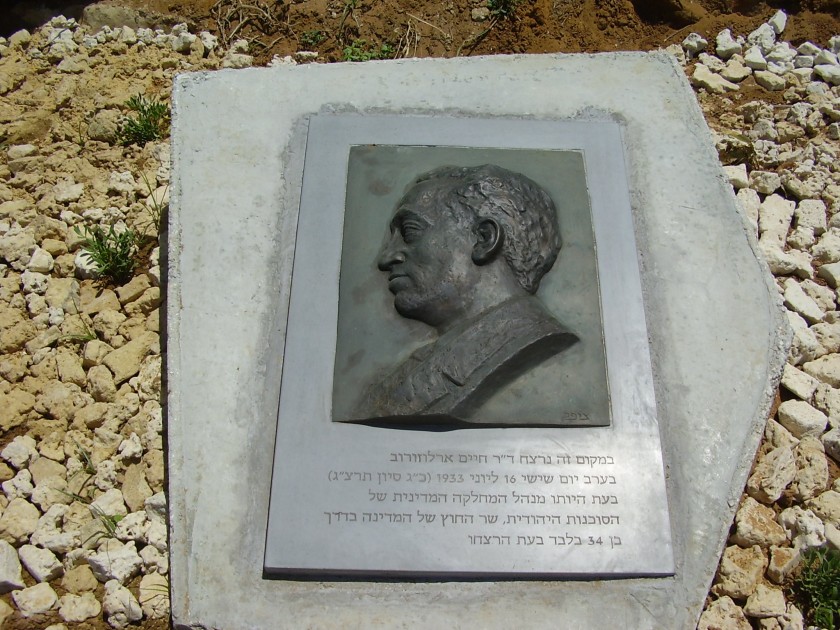
Haim Arlosoroff Memorial in Tel Aviv
On the night of June 16, 1933, Haim Arlosoroff was murdered on the beach in Tel Aviv, a couple of hundred yards from the very tip of the street that is named after him, Rehov Arlozorov, familiar to all visitors to the city. Arlosoroff (I’ll use the pre-state spelling) was the thirty-four year old head of the Jewish Agency’s political department and one of the leaders of Ben Gurion’s Labour Zionist Party. He had recently returned from Germany, where he had negotiated a highly controversial agreement with Hitler’s newly formed Nazi government. Under the terms of what came to be known as “The Transfer Agreement” Jews fleeing persecution in Nazi Germany would be able to leave, not with their money, but with permission to buy German goods and export them to Palestine. The Nazis hoped to ease the international boycott on their regime and boost their own economy, and the Jews of the Yishuv wanted to rescue German Jews from their rapidly deteriorating situation and vivify their own economy with German products. Arlosoroff became a target of Jabotinsky’s Revisionists, excoriated in the Jewish right-wing press for doing a deal with the devil. For Arab political leaders the deal was also anathema, as it opened the way for increased Jewish immigration from Europe to Palestine.
Who murdered Arlosoroff? After ninety years the jury is still out. Three men associated with the Revisionist movement – Avraham Stavsky, Zvi Rosenblatt, and Abba Achimeir – were tried in May 1934 for the murder. Stavsky was convicted, a verdict that was overturned on appeal; the other two were acquitted. For Labour Zionists, the trial – run by the British Mandate authorities – had resulted in a miscarriage of justice. For many others, the killers were undoubtedly Arabs, a version of events reinforced by the confession of an Arab teenager, Abdul Majid, who indicated that he and a friend wanted to sexually assault Arlosoroff’s wife, Sima. But Abdul Majid quickly retracted his admission of guilt, claiming that he had been bribed to confess. The waters were further muddied by Sima, who witnessed the killing but offered contradictory accounts of her husband’s assailants, describing them sometimes as Jews but other times as Arabs. Whatever the truth, the murder, as the eminent Israeli political scientist Shlomo Avineri wrote, became “the most notorious political murder case in modern Zionist history…parallel in its intensity perhaps only to the impact of the Dreyfus Affair on French politics.” The emotional and ideological rift that exists today between the left and the right in Israel didn’t begin with Arlosoroff’s murder, but it cemented a polarization now in place for almost a century.
Who murdered Arlosoroff? After ninety years the jury is still out.
On my desk, next to my computer as I write, I have a thin book with a partially broken spine, tattered black cover, and some brown-stained pages. Its title is The Arlosoroff Murder Trial: SPEECHES and RELEVANT DOCUMENTS published in Jerusalem in July 1934, only weeks after the trial had ended. It is a truly extraordinary book, for not only does it detail almost every aspect of the trial, but also, within the Rumpole of the Bailey type oratory of the highly sophisticated British Mandate barristers, it powerfully evokes the milieu of Mandate Palestine as a place of competing narratives, with vivid characters, including Arabs, Brits (including British Jews working in the Mandate Administration) and local Jews, political figures, criminals, police officers, lawyers, and a host of minor characters all creating friction in a tinderbox world.
This was the book that sent me on my way to The Red Balcony. I wrote a novel and not a history, so I was able to expand the borders of the milieu and add in a group of bohemian artists, poets, and writers active in Tel Aviv and Jerusalem at the time of the murder, loosely based on some figures whose work I was familiar with and admired. I also took the fictional liberty of incorporating not only the real historical figures of Haim and Sima Arlosoroff, but also references to some offstage players in 1933 to 1934 Jerusalem including Gershom Scholem and Albert Einstein. Most urgently, I invented a young Anglo-Jewish character, Ivor Castle, a recent graduate in jurisprudence from Oxford, out in Palestine to assist the lead barrister for the defense. Ivor falls in love with one of my imaginary witnesses, a mysterious and charismatic Jerusalem artist, Tsiona Kerem. In the trial documents there is no hint of a love story, but there had to be one somewhere, didn’t there?
Jonathan Wilson is the author of eight previous books, including the novels The Hiding Room, runner up for the JQ Wingate Prize, and A Palestine Affair, a New York Times Notable Book, and runner up for the 2004 National Jewish Book Award; two collections of short stories, Schoom and An Ambulance Is on the Way: Stories of Men in Trouble; and the soccer memoir Kick and Run. His work has appeared in The New Yorker, ARTnews, Esquire, The New York Times Magazine, The New York Times Book Review, Tablet, The Times Literary Supplement, and the Best American Short Stories, among other publications. Wilson has been the recipient of a Guggenheim Fellowship, and his work has been translated into many languages. He lives in Newton, Massachusetts.